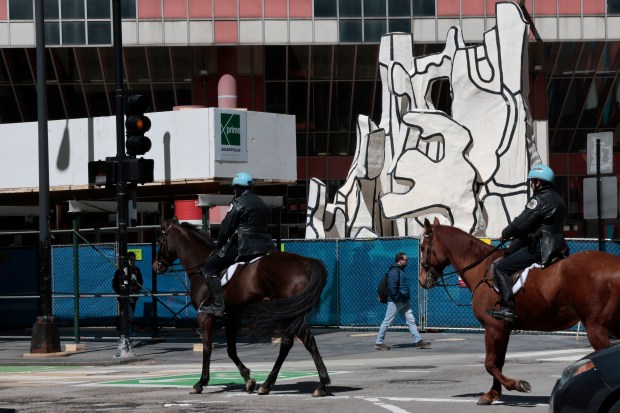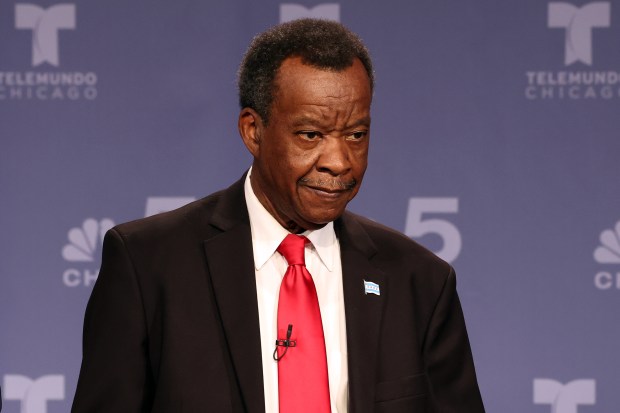One of the few positive things that came from the pandemic was the expansion of outdoor dining. As restaurants lined the street with tables and patrons flocked to socialize safely, we were brave enough to turn a few car-congested roads into mini public squares. These programs have been incredibly popular and should be continued every year.
The most popular example of Chicago’s Expanded Outdoor Dining Program was in River North on Clark Street. Police saw increased safety, local businesses saw increased revenue, and residents saw the increase in community a pedestrian plaza could bring. Despite this, Ald. (Brendan) Reilly announced these permits would not be accepted for 2024 but placed the blame on Mayor Johnson, who cannot be reached for comment. While these city officials point fingers on Twitter and obfuscate who is really responsible for this decision, Chicagoans’ frustration grows.
At Strong Towns Chicago, we launched a petition to reclaim this stretch of Clark for pedestrians. In under 24 hours, it had already garnered 1,000-plus signatures and has since surpassed 2,500. Chicagoans overwhelmingly support outdoor dining as shown in a 42nd Ward survey last year where 79.7% of respondents said they are strongly in favor of making Clark Street car-free. We see the vibrancy this pedestrianization of Clark Street brought to River North, the additional income it provides to local business and employees, and the sustainability it promotes by encouraging walking and biking.
Tourists flock to European cities to spend their money, in part, because those pedestrian-friendly cities allow you to walk from restaurant to restaurant without crossing a dangerous intersection. Our experiment of only one street, for only a few blocks, was incredibly successful. Let’s continue this prosperity and ensure outdoor dining isn’t just a relic of the pandemic. Let’s prioritize reclaiming our public spaces for the good of the entire community, not just drivers.
— Aaron Feldman, Chicago
Jane Byrne helped make Chicago a movie-making center
Thank you for publishing the excellent article by Michael Peregrine (April 3) on the late Mayor Jane Byrne’s legacy. However, his comment on the lack of “substantial achievement” during her one term as mayor overlooks what I believe to be one outstanding and enduring accomplishment of her administration. That is her transformation of Chicago into a significant site for film and TV locations shooting and production, a status the city still continues to enjoy.
Prior to Byrne, Chicago had no major film status after important silent film studios left Chicago for Hollywood in the 1920s. Worse, longtime-serving Mayor Richard J. Daley continued the drought of film production reportedly because he hated the Hollywood depiction of Chicago as an epicenter of organized crime. Film production was not encouraged or supported by Daley or (successor Michael) Bilandic.
Jane Byrne changed this completely. She championed the location shooting for “The Blues Brothers” in 1979, which became a cult classic and a Chicago favorite. Byrne and her daughter famously vamped in fedoras and sunglasses with stars John Belushi and Dan Ackroyd. Thereafter, the Byrne administration promoted major film and TV production in the city, resulting in enduring hits or iconic movie scenes like “The Hunter” and “Risky Business.” With tax incentives and other government support, the floodgates of movie and TV production were opened, and included the creation of Chicago-based production and film support businesses. Now, a week doesn’t go by without something filmed on the streets of Chicago. Thanks to “maverick” Mayor Byrne, Chicago continues to have standing in the TV and film industry, showcasing our great city around the world.
— John Curry, Chicago
Frustration with giving losing mayoral candidates repeated space in Opinion section
I wholeheartedly agree with William Wyatt’s thoughts in (the April 8) Tribune on seeing the seemingly never-ending op-eds in the Tribune from those who lost in the Chicago mayoral election, especially Willie Wilson.
Willie Wilson’s op-ed might have been the most offensive op-ed I’ve ever read in this paper and considering the list of authors to grace the op-ed pages that is quite a feat.
He suggested that leaders lead with godly values. But after reading that op-ed from a man who considers himself a godly man, would those values be intolerance and disrespect to anyone who doesn’t believe what he does? Mr. Wilson supplied stats showing people having been leaving the church for the last 50-plus years. After reading his self-righteous criticisms of others and how he can do it so much better, it’s not really hard to imagine why.
— Brian Collins, Orland Park
No Labels needs to focus first on lower offices than president
If a third or even fourth political party is going to credibly offer voters a legitimate presidential option it needs to build from the bottom up, not the top down. Third-party presidential campaigns need big money in the bank to compete with the two legacy parties and the special interests that in many ways corrupted them.
So No Labels’ inability to settle upon candidates for the 2024 presidential race came as no surprise. I believe that a political party that does not carry the name and the baggage of GOP or Democrat is more likely to offer a viable national third-party candidate only after first building a legitimate local (city, county, state and congressional) platform and getting its candidates elected under its (No Labels) banner. Third-party support evolves from voters’ enthusiasm for its policies and a willingness to give money to get those policies voted into law.
No Labels was unable to succeed this year despite the fact that a large number of voters want candidates other than Trump and Biden. At the congressional and state level the polarization of America’s two leading political parties has blocked many sensible ideas from becoming law. It has also on occasion led to some very ill-conceived and dangerous ideas becoming law. I hope No Labels will focus its energies on becoming the voice for the many true independent-thinking voters and dissatisfied Republicans and Democrats. In some jurisdictions it may not be too late to identify and finance candidates for local, statewide and congressional offices in 2024. Then there is 2026. Count me in. We need a No Labels. We need it badly.
— David Kahn, Scottsdale, Arizona
If legacy admissions is a form of affirmative action, what about athletes?
In his op-ed on affirmative action (April 8) Sheldon Jacobson states that legacy admissions are a form of affirmative action and, as such, should be eliminated: “past giving should neither help nor hinder one’s academic opportunities.”
It is interesting that Professor Jacobson does not mention athletic admissions as a form of affirmative action. Could this be because he teaches at the University of Illinois at Urbana-Champaign, a school whose teams compete in the NCAA Division 1? Or perhaps he does not believe that some athletes’ “applicant qualifications diverge from the admissions doctrine.”
— Richard Badger, Chicago
What to do with the Dubuffet sculpture: Leave it

Regarding your brief piece in Saturday’s (April 6) paper on the disposition of the quirky and significant Dubuffet sculpture, I guess I don’t understand the controversy surrounding its future. Its placement on the corner of the block with the bold Helmut Jahn building as backdrop is perfect. Why can’t it simply go back there after Google finishes its much needed restoration of that great building?
Avani Kalra doesn’t provide any information about Google’s status in relation to the sculpture and the Pritzker office pronouncements are frustratingly vague.
All this when the answer is so very simple — leave it right where it is, which is where it was always meant to be.
It was always a fun piece of street sculpture to walk by in the everyday hustle and bustle of city life. It brings a smile to art lovers and kids who like to play hide ‘n’ seek. Let’s please keep it right there in the heart of the city!
— Dennis Allen, Wilmette
Inclusion of public art allows for taller buildings?
I write to correct a statement in the Saturday, April 6 Tribune in the article “Work crews begin removing Standing Beast sculpture from Thompson Center courtyard”.
Ward Miller of Preservation Chicago is quoted in the article as saying, ““We’ve been watching these really magnificent works of art that were once part of the reason these buildings were allowed to build to a certain height.”
I’m a docent at Chicago Architecture Center and was executive director of an organization I founded called Public Art Chicago. I worked with another docent to determine how the story arose that the inclusion of art in a building’s design allows any concession for increased height of the building. The other docent worked at the time for the city of Chicago and scoured Chicago ordinances for any suggestion that art had anything to do with permitting greater height. No such ordinance exists, nor are there any building regulations that allow for such concessions. There are, indeed, regulations about the inclusion of open space in the overall design of the building providing for greater height. But art is not a factor in building height at all.
Let me add that besides the Dubuffet sculpture, the Thompson Center was the home of a significant portion of the state of Illinois’ “Art in Architecture” collection. In the heyday of this state office building, it held more than 100 works of art, nearly one-sixth of the entire state collection. Those works — including sculpture by John Henry and Richard Hunt and paintings by several of the Chicago Imagists and the “Hairy Who” — have been removed to an unknown location as well.
— Edmund J. McDevitt, River Forest



